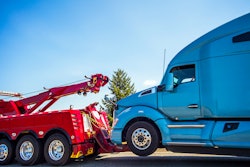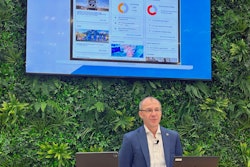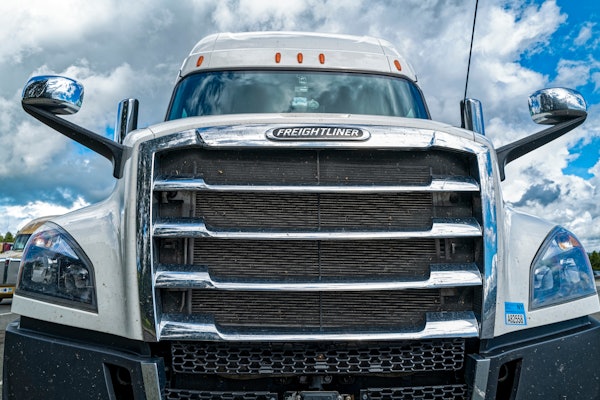A lot of what happens in trucking is very analog, and there may be no greater example of that than a pre- and post-trip inspection: two manual and very hands on processes. You either do them, and physically inspect the components, or you don’t.
Joining the 10-44 this week is Zonar Vice President of Safety and Compliance Fred Fakkema says, who says that digitizing the inspection documentation processes with eDVIRs and EVIRs improves record-keeping, communication and accountability, which improves safety outcomes.
Contents of this video
00:00 Pre- and post-trip inspections
01:12 eDVIRs and EVIRs
01:53 Streamlining communication
03:45 Safety compliance
06:55 Documenting safety culture
08:58 Verified electronic inspection
10:00 Roadside inspections and enforcement campaigns
Jason Cannon:
This week's 10-44 is brought to you by Chevron Delo 600 ADF ultra low ash diesel engine oil. It's time to kick some ash.
Let's not forget about maintenance specifically pre- and post-trip inspections as part of trucking's digital transformation. You're watching CCJ's 10-44, a weekly webisode that brings you the latest trucking industry news and updates from the editors of CCJ. Don't forget to subscribe and hit the bell for notifications so you'll never miss an installment of 10-44.
Hey everybody, welcome back. I'm Jason Cannon and my co-host, as always, is Matt Cole. A lot of what happens in transportation is very analog. It's very black and white. And there may be no greater example of that than pre- and post-trip inspections.
Matt Cole:
Both the pre- and post-trip are manual and very hands-on. You either do them and physically inspect the components or you don't.
Jason Cannon:
While you can't digitize the inspection process, things like eDVIRs and EVIRs have helped to digitize the record keeping process. Zonar Vice President of Safety and Compliance, Fred Fakkema, who joins the 10-44 this week says that kind of documentation has helped improve maintenance outcomes because, for one, it creates a crumb trail even when one's not required.
Fred Fakkema:
If you do not have a defect, you don't have to fill out a piece of paper, but when you do it digital, you maintain that inspection for day in and day out. So it's just easily done and is easy to observe. The other aspect of it is when you do find a defect and it's sent to maintenance, now you have a tracking mechanism. It's easy to read, easy to follow. They can fulfill the work order and see when it's closed out. That way it makes it easier. On the next pre-trip, the driver does the inspection. He reviews previous inspection. You can see what was there, what wasn't. Maybe there wasn't anything there. Maybe there's a defect that was repaired. So it is a lot easier from that aspect of it.
Matt Cole:
eDVIRs and EVIRs can also streamline communication between the driver and shop because, let's be honest, that can be a contentious relationship at times when a driver finds a defect.
Fred Fakkema:
I was in law enforcement for 25 years, and so like a good doctor too, I can't read my writing. And I can tell you that, I'm sure, a lot of drivers, you can't read their writing or what they're putting on a inspection. So when you digitize it and you do an electronic verified inspection, you know what's being sent. The other thing is when there is a defect or you believe there's a defect, you can take a picture of it, attach it to that inspection, and send it along. And now it's actually there. And then you have the follow through, too. So a supervisor can see how long the driver's doing the inspection, is it just a pencil whip or are they actually saying what they really see? And then is the mechanic really fixing it? And so now it's real time. It's not sending a paper into the office and somebody looks at it, makes the decision, and now you probably have an hour or two even more.
It could be a day while someone's getting it done where this is real time, the decision being made now. And now you have the processes to follow it through to make sure that that defect's taken care of before the truck goes on the road again. You're actually streamlining the effectiveness of your pre- and post-trip by having it digitized, being real-time rather than a piece of paper being turned in. You can see what the drivers are doing. Everything's clear. It's legible. It's done right. And then on the back end, you get the document electronically, you review it, you make the corrections to the vehicle, you have a work order, you have a integrated system with your fleet maintenance software. It's all seamlessly done in one stroke, if you will, rather than having to have egregious process that takes forever.
Jason Cannon:
Shop personnel already get a lot of reports sent their way. Health reports, fault code reports, repair status updates. Isn't the EVIR just one more thing to look at?
Fred Fakkema:
It's another tool in the toolbox to get it done correctly. To really streamline it and to make it more effective for that manager because they should be doing that pre-trip and they should be doing it right. And then they should follow up with that post-trip afterwards so that there are any defects pre next driver can manage that. So it's what you want and how you manage that. Everybody has their secret sauce on how they do things and how they manage their program. But if you zero in on what needs to be done and how it needs to be done correctly, it makes that process that much easier and you know that your vehicles are safer. Safer vehicle means safety compliance at the roadside. We know that a pre-trip, if it's done correctly, will eliminate some of those easy roadside inspections that are found by enforcement during that period of time.
There's a lot to be said about how a pre-trip and a post-trip set the safety culture for that carrier and doing it the right way really illuminates that. I know our customers when they start with EVIR, they look at it and think, I want to be alerted every time there's a defect or something. And they get swamped with all that data because what happens is the pre-trip haven't been done correctly. So you'll see the hockey stick spike of defects go up. The reason it goes up because now they're actually doing the pre-trip. But once you correct those defects, it starts to go back down to where it was. But now you know it's down to where it was, but the truck's actually safe because you're actually doing the pre- and post-trip effectively and done right and those defects are getting corrected.
Matt Cole:
Having a quality paper trail that documents the efforts a carrier takes to maintain its safety culture is a key part of a legal defense strategy. Fred talks about how after word from 10-44 sponsor Chevron Lubricants.
Jason Cannon:
Protecting your diesel engine and its aftertreatment system has traditionally been a double-edged sword. The same engine oil that is so essential to protecting your engine's internal parts is also responsible for 90% of the ash that is clogging up your DPF and upping your fuel and maintenance costs. Outdated industry thinking still sees a trade-off between engine and emission system protection and Chevron was tired of it. So they spent a decade of R&D developing a no compromise formulation.
Chevron Lubricants developed a new ultra low ash diesel engine oil that is specifically designed to combat DPF ash clogging. DELO 600 ADF with omnimax technology cuts sulfate ash by a whopping 60%, which reduces the rate of DPF clogging and extends DPF service life by two and a half times. And just think what you can do with all the MPGs you're going to add from cutting your number of regions. But, Delo 600 ADF isn't just about after treatment. It provides complete protection extending drain intervals by preventing oil breakdown. Before you had to choose between protecting your engine or your aftertreatment system, and now you don't. 600 ADF from Delo with omnimax technology, it's time to kick some ash.
Fred Fakkema:
The question is, should that vehicle been there anyways? Should that driver have been there anyways? Whose hours of service is up-to-date? Is the inspection processes, is everything done correctly on both ends of the spectrum? And when you can say yes, then that's easier to fight. You do get a lot of that, do I want to be offense or do I want to be defense during a trial period? I would suggest it's easier to be offensively ready to go than defensively when an attorney is looking at your inspection or your safety processes with inside your operation. And say you have a driver get a roadside inspection and the tire was worn and that inspection was done on a day. When it comes back to the shop, was there a post-trip that was done? The next day, was that tire fixed on the pre-trip?
If it wasn't, it shows that you're not doing your pre- and post-trip inspections. If you digitize it and our processes on electronic verified, we verified that that driver got out of the seat, walked around the truck, inspected each zone, knows that it was done correctly. And you should now show that you have a safety process in place and you're creating that safety culture within your carrier. And that is a better way to go at it in a lawsuit than trying to make up for those lack inspections that might not be there. When you do a proper pre-trip, you're really getting ready for your drive. You get in that safety mindset. You walk around the truck, make sure it's safe. You're starting to think about that safety. You visualize what you're going to do going down the road and do that. All the great athletes do it. They prep, they stretch, they get ready before they go out and hit the field. They visualize. And our drivers are doing the same thing. The good drivers that you talk to, they do it. We just got to reinforce that within the industry.
Jason Cannon:
Now, we've all heard the term pencil whipping and we all know what it means. And just because you take the pre- and post-trip process and make it electronic, that doesn't make it immune to pencil whipping. But, it does create some hurdles.
Fred Fakkema:
You can sit inside the cab, you can just check a box, send it on in, never get out of the seat. That's why the verified inspection gets the driver out. And we know how long the driver is in a specific area. It's all date and timestamped on every specific zone and how often the driver got out. And it is what needs to be done if you don't want to have those roadside inspections. And we all know that when you get pulled over for a roadside inspection, it could go anywhere. Especially, if you have a defect like something simple there's a headlight out or a marker light out, that's the low hanging fruit that brings you in in the first place. And now you're going to get a level 1 37-point inspection done by enforcement. They're going to look at all your hours of service. They're going to look at everything else. That leads one thing to another, and you're actually losing money rather than being effective in doing a proper pre-trip in the beginning anyway.
Matt Cole:
All of this can go a long way to finding more success at roadside inspections and enforcement campaigns, too.
Fred Fakkema:
As you know, CBSA has a road check and operators check. All these programs that they do for the safety of the roadway. And the median is highlighted. It's always the same time a year. But yet you always have 11 to 20% out-of-service rate. You always have the same violations that are taking place. You can look at the top 20 violations that are out there at roadside. They're simply correctable if you do a proper pre-trip. You have inoperable required lamps, turn signals not working, brakes, license plate violations, flat tires, audible air leaks. All these things that can be found during the pre-trip that should be done, they're found during these safety checks that are advertised and they're still not getting it done. So it's those carriers that take that chance on safety that really has that bag negative impact on the industry when the industry really is a safe industry. And we just cut down praising all the truck drivers for all the work that they do. And doing the proper pre-trip really makes a difference at roadside, as well.
Jason Cannon:
That's it for this week's 10-44. You can read more on ccjdigital.com. While you're there, sign up for our newsletter and stay up to date on the latest in trucking industry news and trends. If you have any questions or feedback, please let us know in the comments below. Don't forget to subscribe and hit the bell for notifications so you can catch us again next week.










